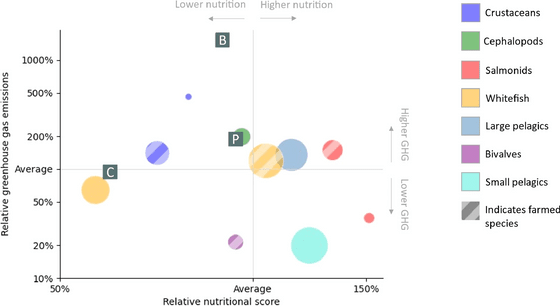Research results that carbon dioxide emissions can be reduced just by making meat of meals fish, and there is no complaint in terms of nutrition

The livestock industry for producing delicious meat
Assessing seafood nutritional diversity together with climate impacts informs more comprehensive dietary advice | Communications Earth & Environment
https://doi.org/10.1038/s43247-022-00516-4
Fish and seafood are better for your health and the climate than meat, study shows
https://www.inverse.com/science/seafood-better-than-meat-health-environment-greenhouse-gases
It has long been pointed out that replacing beef, pork, and other sources of protein in the diet with seafood may reduce greenhouse gases. However, seafood contains important nutrients other than protein, such as essential fatty acids and vitamins. increase.
Therefore, a research team led by Peter Tidemers, who is studying environmental studies at Dalhousie University in Canada, comprehensively evaluated the nutritional value of foods other than protein, and calculated the amount of greenhouse gases required to consume it. was compared between fish and shellfish and livestock on land.

19 beneficial nutrients such as omega-3 fatty acids, vitamins and minerals were evaluated. On the other hand, sodium and fatty acids, whose overdose tends to be a problem, were treated as negative factors for nutritional value. In addition, 14 types of farmed fish and 27 types of wild caught fish were compared, totaling 41 types, and the land livestock was 3 types of cattle, pigs, and chickens. In addition, fish and shellfish for which data on environmental impact are insufficient were excluded from the environmental assessment.
As a result of the comparison, 22 (54%) of the 41 types of seafood evaluated for nutritional scores and 17 (50%) of the 34 types evaluated for environmental scores were beef, pork, and chicken. I have found that I am getting much better results. Especially in terms of nutrition, it was a masterpiece, and only white fish and some shellfish scored lower than land livestock.
Below is a graph showing detailed comparison results, with the vertical axis representing the environmental score and the horizontal axis representing the nutritional score. The circles are for seafood: blue for crustaceans, green for cephalopods, red for salmon, yellow for white fish, blue-grey for large pelagic fish such as tuna, purple for clams, and light blue for small pelagic fish such as mackerel. For fish, those with diagonal lines are farmed. Also, B is beef, P is pork, and C is chicken. Overall, both wild and farmed salmon are excellent, and wild salmon in particular has a very high nutritional value and a low environmental impact. On the other hand, wild whitefish and farmed crustaceans were relatively less nutritious.

Regarding this result, Eleanor Hallström of the Swedish RISE Institute, co-author of the paper, said, `` Seafood is better in terms of mitigating greenhouse gas emissions.
While acknowledging that there is a lack of data, Tidemars said, ``We must significantly reduce our consumption of ruminants such as cattle, and seafood is a great substitute. will be,' he said.
Related Posts:







